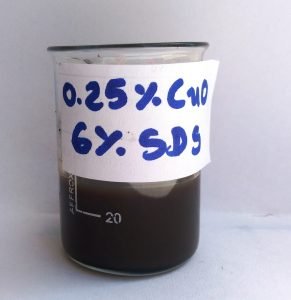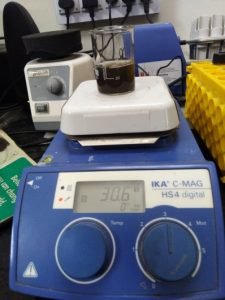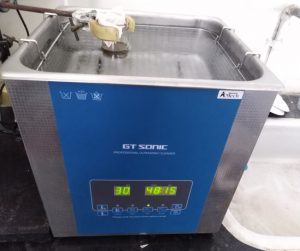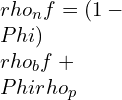Following contents are explained in this articles:
- Nanofluid definition | what is nanofluid?
- What is base fluid?
- How do you make a Nanofluid?
- What is hybrid nanofluid?
- Uses of nanofluid | applications of nanofluid
- Types of nanofluid & Its Poperties
Nanofluid definition | What is nanofluid?
Nanofluid is fluid that consists of a base fluid with nanosized particles (1–100nm) suspended in it. Nano particles used in this type of studies are made of a metal or metal oxide, increase conduction and convection, allowing for more heat transfer. In the past few years, high-speed advancement in nanotechnology has made emerging of new generation coolants called nanofluid.
Let’s take example, check figure below. The CuO (metal oxide) nanoparticles are added to make nanofluid with a volume fraction of 0.25% CuO. The nanoparticle is dispersed in distilled water (base fluid). The surfactant sodium dodecyl sulfate (SDS) is added to the nanofluid for the stability of nanoparticles.

What is base fluid?
The nanoparticles are suspended in some ordinary liquid coolant like distilled water, ethylene glycol, oil, refrigerants, etc. This widely used ordinary coolant is known as base fluid.
You might have noticed while mechanic changing or pouring coolant in your car radiator. Do you remember its color? Yes, it’s green. That green colored fluid (coolant) is ethylene glycol.
Let’s know about base fluid oil. You might have noticed mechanic changing oil from your car or bike. It is lubrication and transmission system oil. This type of oil can be base fluid for nanofluid preparation.
How do you make a Nanofluid?
The preparation of nanofluid can be possible by following two widely used methods. It is prepared by dispersing nanoparticles in base fluid with a magnetic stirrer and sonicator, as shown in figure “Preparation of nanofluid : Sonicator”.
There are two types of stirrer used to disperse particles into basefluid, one is the magnetic and another is mechanical. The another lab instrument called ultrasonic sonicator is also required for proper dispersion.


Two-step method
The two-step procedure is the most widely used method for preparing nanofluid. The chemical and physical peocesses are used to produce dry powder of nanoparticles.
The powder of particles is added into the base fluid. The second step could be intensive magnetic force agitation or ultrasonic agitation. The two-step procedure is the economic procedure to produce nanofluid on bulk because the nano fluid requirements are raising with new applications.
Use of surfactant in nanofluid
The nanoparticles have large surface area and surface activity which lead to aggregate. The use of surfactant is convenient method to get good stability. However, the surfactants’ functionality under high temperatures is also a big issue, especially for high-temperature applications.
One-step method
Eastman suggested a one-step method of vapor condensation. It is used prepare Cu/ethylene glycol (EG) nanofluid to limit the agglomeration of nanoparticles.
The use of one-step preparation method avoid spreading the particles in the fluid. There are some function not needed in this method. This method eliminates drying of particles, storage of material, and spreading. Agglomeration is limited in one -step method. it also increases stability of nanofluid.
Vacuum method – SANSS
(full form Submerged -arc -nanoparticle -synthesis- system)
It is one of the preparation method of nanofluid with good efficiency. Different dielectric fluid are used in this method
The shape of nanoparticles are like different different type. The procedure avoids the undesired particle aggregation reasonably well. There are some disadvantages of this method. There is some reactant remain present in nanofluid.
What is a hybrid nanofluid?
A hybrid material is a combination of physical and chemical properties of two or more materials. The two or more nanoparticles are dispersed in a base fluid to achieve desired properties for individual applications. The making of nanofluid with two or more similar or different nanoparticles is popular as hybrid nanofluid. The work on hybrid nanofluid is not extensively done.
There are many experimental studies on hybrid nanofluid is still left to be done. The generally used hybrid nanofluids are Al2O3/Cu, Al2O3/CNT, Cu/TiO2, CNT/Fe3O4, etc.
The hybrid nanofluid is a new research area for thermal engineering researcher to obtain enhanced cooling system.
Usage of nanofluid
Nanofluid can be utilized for various different applications. These uses not affecting energy transfer thoroughly, they may be reduce the basic need for conventional fuel, electrical energy, or gas. Let’s read some important application of nanofluids
Electronic devices cooling
The research going on the electronics suggests that the use of nanofluid can perform superior heat transfer. The vapour chamber is utilizing nanofluid in it for better heat transfer.
Jacket-water fluid in electricity generator
The management of machinery space is main problem in all automobile vehicle. The size of component (cooling) can be reduced only if we improve heat transfer performance of parts. The nanofluid is the one of the option to improve performance of part and develop compactness.
Solar energy – thermal energy system
To absorb solar radiation, the working fluid is passes through solar thermal energy system. The energy absorbed by fluid is sent to heat exchanger for other purposes.The solar energy absorbed by working fluid is generally transferred to the heat exchanger for other applications.
Cooling oil in Transformer
The transformer is power transmission electrical equipment. The generated heat in transformer is absorbed by oil. If we add nanoparticle in cooling oil. The performance of transformer can be improved.
Other usage of nanofluid in the field of heat transfer enhancement:
Refrigeration process
The refrigeration process is working on different thermodynamic cycles. The working fluid in this process is refrigerant. The thermal properties of some refrigerant can be improved by use of nanoparticle.
Cooling system of nuclear energy
The huge amount of heat is produced in the nuclear fission. It is required to arrange proper cooling to system. The nano fluid is advance fluid which can be utilized in nuclear cooling system.
Types of nanofluid
The types of nanofluid are dependent on the use of different types of nanoparticles and base fluids. There are three types of nanoparticles, like pure metal, metal oxide, and carbide-based nanoparticles. These particles are dispersed in various choices of base fluids like water, water/ethylene glycol, oil, ethylene glycol, etc.
| Pure Metal | Metal oxides | Carbide |
| Al | Al2O3 | Diamond |
| Cu | CuO | Graphite |
| Fe | Fe2O3, Fe3O4 | Single wall nanotube |
| Ag | Ag2O | Multiwall nanotubes |
| Zn | ZnO | |
| Ti | TiO2 |
Properties of nanofluid
Thermal conductivity is one of the vital property related to heat transfer for nanofluid. It is high thermal conductivity compared to standard cooling liquid, it is an essential characteristic for many applications. Use of copper nanoparticles with ethylene glycol results in an increase in thermal conductivity by 40% compared to the base fluid.
All processes indicates that thermal conductivity basic for proper cooling system in any devices. In the cooling system, a large surface area and high thermal conductivity are attributed to this heat transfer improvement.
The ratio of surface area and volume is main criteria for thermal conductivity improvement. This ration can be increased by using small size nanoparticles. The thermal conductivity is raised by using higher concentration of the particles.
The properties like density, viscosity, specific heat, thermal conductivity are well known for base fluid. The properties of nanofluid can be calculated theoretically by correlations suggested by various researchers. These properties also can be measured with multiple instruments experimentally in the lab.
The density of nanofluid can be calculated using correlation as

Where ρpand ρbfare the nanoparticles’ densities and base fluid, respectively, and фis the volume concentration (% w/w) of nanoparticles dispersed in the base fluid. As per the idea of the strong fluid combination, the specific heat of nanofluid is given by the accompanying:

Where cppand cpbf, are the specific heat of the nanoparticles and base fluid, respectively. The viscosity of nanofluid can be obtained from the following equation:
![]()
Credit Einstein 1906
a is constant in viscosity equation and its value is 14.4150 to calculate viscosity. This formula is basically given for Brownian motion of particle in fluid. One well-known formula for computing the thermal conductivity of nanofluid is the Kang model which is expressed in the following form :

Credit Hamilton and Crosser (1962)
Question and Answers
What is nanofluid?
It is an advance fluid. It is prepared by dispersing nanoparticles in the base fluid.
What is base fluid?
The base fluid is conventional coolant liquid. It is used to prepare nanofluid.
Give the examples of some commonly used nanoparticles to prepare nanofluid.
The commonly used nanoparticles are Copper (Cu), Aluminium (Al), Iron (Fe), Aluminium Oxide (Al2O3), Copper Oxide (CuO), Titanium Oxide (TiO2 ) etc.
What are widely used preparation methods of nanofluid?
There are two methods widely used mentioned as below:
- Two-step method
- One-step method
What is the stability of nanofluid?
The stability can be stated as how long the particle keep dispersed in the base fluid. Technically, The higher stable nanofluid is one who has less sedimentation.
What is the use of surfactant in preparation of nanofluid?
The surfactant is used in nanofluid to increase its stability. The commonly used surfactant is sodium dodecyl sulfate (SDS).
Why hybrid nanofluid became a new research topic?
The individual application needs the desired properties of the material. To get likely properties in nanofluid, more than one nanoparticles are added in the base fluid.
Why the use of nanofluid results enhanced heat transfer?
The nanofluid is an advanced fluid with a higher thermal conductivity as the nanosized particles provide more surface area to conduct heat transfer.
How can nanofluid reduce the size of the heat exchanger?
The convention coolant used in heat exchanger shows less heat transfer as compared to nanofluid. The use of nanofluid requires proportionally less sized heat exchanger as compared to the conventional coolant.
Conclusion
This article is about basic introduction of nanofluid, preparation of nanofluid, application of nanofluid and properties of nanofluid. Recently, it is advance coolant in heat transfer applications. The scope of nanofluid is vast in present nanotechnology world. The nanofluid and its applications can be a good topic for students and researcher for project work.
For more details regarding it, please refer click here
More topic related to Nanofluid and heat transfer, please click here

I am Deepak Kumar Jani, Pursuing PhD in Mechanical- Renewable energy. I have five years of teaching and two-year research experience. My subject area of interest are thermal engineering, automobile engineering, Mechanical measurement, Engineering Drawing, Fluid mechanics etc. I have filed a patent on “Hybridization of green energy for power production”. I have published 17 research papers and two books.
I am glad to be part of Lambdageeks and would like to present some of my expertise in a simplistic way with the readers.
Apart from academics and research, I like wandering in nature, capturing nature and creating awareness about nature among people.
Also refer my You-tube Channel regarding “Invitation from Nature”